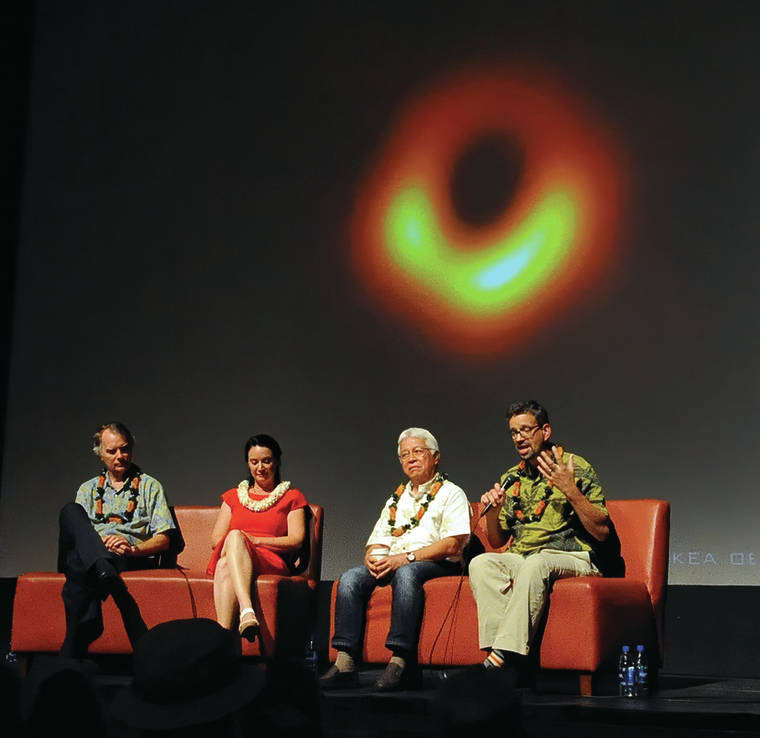Discovery named with nod to science and culture
WAIMEA – A Hawaiian name has been bestowed upon the first captured image of a black hole, a picture that proves their existence.
As part of its talk series, The W. M. Keck Observatory held a presentation Thursday at Kahilu Theatre on the discovery, imaging and naming of a black hole located in the M87 galaxy — a mere 50 million light years away.
Rich Matsuda, Keck’s Chief of Operations, opened the evening by telling the audience that it has been a complex and historic time the past month with the protests on Maunakea. Many strongly held perspectives have come to the forefront.
“It has been an unprecedented time of complexity, emotions and struggle, but also an amazing opportunity for introspection and learning for every one of us,” he said.
A panel of experts featured Geoffrey Bower, chief scientist for Hawaii Operations ASIAA, Jessica Dempsey, deputy director East Asia Observatory and James Clerk Maxwell Telescope, Larry Kimura, Hawaiian Language and Cultural associate professor of the College of Hawaiian Language, University of Hawaii at Hilo and Doug Simons, executive director at Canada-France-Hawaii Telescope.
They discussed the monumental discovery of the celestial object and subsequent Hawaiian naming, “Powehi.” It was April 10 when it was announced that the first image of a black hole, using the Event Horizon Telescope, was captured.
The telescope, which actually consists of nine radio telescopes located in Hawaii, Chile, Spain, Mexico, Arizona, South Pole and Greenland, acted in concert to obtain the image.
Dempsey explained that if you have two radio telescopes a distance apart, and they are both looking at the same thing and you know within a billionth of a hair the distance between them and timed the collection of data to a billionth of a second, you can synthesize the data from one to the other and essentially have a telescope as big as the distance between them.
This black hole, which is one of the biggest astronomers know of, is incredibly far away.
“In order for us to even see this image, you need a telescope the size of the planet,” said Dempsey, which is what they achieved by precisely coordinating the Event Horizon Telescope.
“Black holes are an incredibly important window into our understanding how the universe works,” said Bower.
The image shows a spherical light surrounding darkness.
“We are seeing light that comes from very close to the black hole,” Bower said. “These are sub-millimeter wavelength radio waves that form a light that makes up the glowing ring. The black hole is located in the center. The light seen comes from gas that is surrounding the black hole. The strong gravity bends the light as it goes past the black hole and forms it into that ring.”
So, it exists.
More than 200 researchers from around the globe worked together to compile petabytes (1,000 terabytes equals one petabyte) of data to create the historic image, a feat Dempsey likened to herding cats through a shower.
Simons has been involved in the program A Hua He Inoa, which gives Hawaiian names to new found celestial objects unique to Maunakea and Hawaiian telescopes. Several objects have been given Hawaiian names since the program’s inception.
“In a sense, astronomy is a stage for the Hawaiian language worldwide,” said Simons.
He, along with other astronomers, asked Kimura to name the black hole.
When Kimura heard the description of the object he immediately thought about the epic 2,102-line ancient Hawaiian primordial creation chant Kumulipo, which means the source of darkness.
Translated the first lines read:
When fundamental space altered through heat,
When the cosmos altered, turning inside out,
When the sun was flickering between darkness and light
Attempting to brighten the moon,
When this complete abyss was dotted with tiny stars,
Then began the slime that established a physical space,
The source of impenetrable darkness, so profound.
A fathomless power, reincarnating itself.
The miraculous, the dark, the deep.
The darkness of the sun, absolute, intense darkness.
It is simply darkness, penetrating and fathomless!
Kimura explained the word po, which means very powerful darkness, is recurrent in the chant. Wehi, which also is in the chant, is the embellishment or decorative part of the po.
Kimura explained the meaning of the words to the scientists and suggested naming the black hole Powehi.
They were thrilled.
“To see the creativity of how you can create these new names and new words in the Hawaiian language, and yet it is self-evident about what it means.” said Simons.
“I’m happy to have astronomy provide that conduit and to provide a means by which this beautiful language and culture can be transmitted through the very loud, loud speaker of astronomy and we have found the ears out there are incredibly receptive to this message.”
Kimura said that naming the black hole is a doorway to more than just a name, it’s the beginning of more things to come.
In conclusion, Simons said he hopes that the process of exploring the universe and creating Hawaiian names for newly discovered objects will help debunk the concept of coexistence, which promotes separation.
“This is unification of science and culture,” he said. “I want to see our community move past, beyond coexistence. We are merging through this program.”


